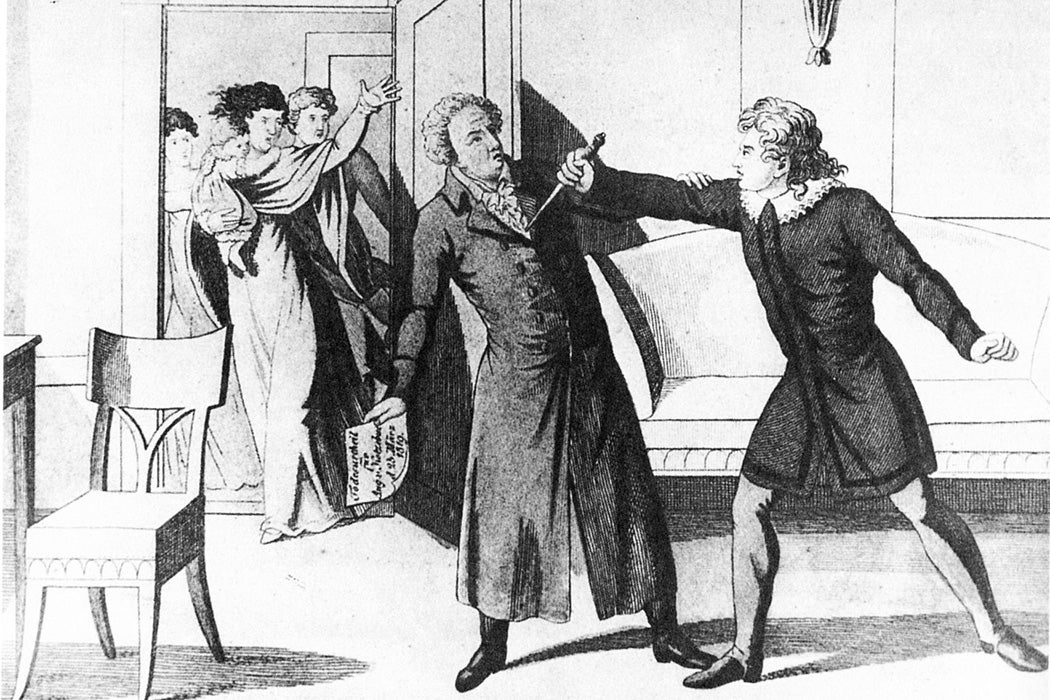The 1819 assassination of prolific playwright August von Kotzebue by theology student Karl Sand is considered one of foundational moments of German nationalism. Historian George S. Williamson describes the aftermath, writing that the murder “became a symbol of resolute, selfless action on behalf of the fatherland.” Sand’s trial, which was followed by his execution “presented the Burschenschaft [student association] movement with a martyr who would be evoked in songs and popular literature for years to come.”
The killing unleashed a reign of repression that only strengthened the resolve of nationalists yearning to unite the hodgepodge of three dozen German states and principalities.
But wait a minute. The victim was a playwright?
By 1819, August von Kotzebue was a fifty-seven-year-old who had enjoyed what Williamson calls “one of the most stellar careers in the history of German literature.” Kotzebue had more than 200 plays to his name as well as numerous other writings. His work had been translated into more than a dozen languages. His plays were performed to acclaim in Berlin, London, Moscow, and New York. He was especially popular among women.
Politically an “archreactionary” and definitely no feminist, Kotzebue nevertheless struck a chord with melodramatic heroines who could “transgress boundaries of sexual behavior without directly challenging the legitimacy of those boundaries,” Williamson explains. In his plays, Kotzebue postulated “a ‘natural’ virtue (typically embodied in this female leads)” that lay outside the conventions of religion, society, and gender. The “seduced innocents” of his plays used an “enlightened sentimentality” to earn forgiveness…and the audience’s tears.
Intellectuals, including less successful playwrights like the now-much-more famous Goethe and Schiller, loathed the sentimentality of it all, while nationalists thought it was all a direct threat to their ideal of a fatherland.
It is also true that Kotzebue, an excellent hater, was targeted because he opposed the nationalists, the Romantics, and the liberals. He thought the unruly students, roiling with radical ideas, should be spanked, and he wasn’t afraid to enter into the polemical fray. He also worked as a Russian consul—he had an estate in Russian-controlled Estonia—so some called him a traitor. Williamson discounts his enemies’ charge that he was a Russian spy, but he does note that Kotzebue liked to tweak the Prussians by reminding them that it was the Russians who had ultimately chased Napoleon out of German territory.
But above all, it was Kotzebue’s very successful plays that most incensed his enemies. And he had a lot of enemies.
Among them was the theology student Karl Sand. In the “hypermoralistic climate” of the university town of Jena, where Sand studied, “art, philosophy, and religion became subordinate to an ethical idea of self-sacrifice for the fatherland.” The student associations and gymnastic clubs (these would be outlawed in the aftermath of the assassination) combined nationalism, antisemitism, and puritanical religious fervor, all supercharged by the memory of the defeat of Napoleon and the dream of a united Germany.
In this fanatic-incubator, Kotzebue’s melodramas were seen as “form of artistic corruption” striking deep into the German soul. In his writings, Sand labeled his nemesis “A.v.K.” a “traitor and seducer of youth.”
Weekly Newsletter
Sand’s “political theology” was a kind of fundamentalism. Like other fundamentalisms, it was deeply imbued with misogyny. Sand and his intellectual mentors—one of them urged his students to kill for the cause, which would excuse the crime—particularly hated Kotzebue because they thought his writings effeminate, his heroines too public, his audience too placidly bourgeois.
“Killing Kotzebue would eliminate a threat to the will of masculine Germany,” writes Williamson. The “ethical reordering of German society” demanded by the Burschenschaftler and their adult teachers required a purging of the reigning feminine sentimentality in the name of “ideals of manliness, strength, and purity.” Karl Sand stabbed Kotzebue to death in the name of morality.
If this all sounds familiar, it’s because we’ve heard it many times since, in all sorts of languages, under flags of all sorts of conviction.
Tip for Teaching:
Read one of Kotzebue’s plays: English-language versions of many of his works are available online.
How were Kotzebue’s characters portrayed? Search for publicity images of the actors who starred in his works (keyword: Kotzebue) in the Folger Shakespeare Library via JSTOR.
How has Kotzebue’s work been presented in the twentieth century? Consider Marcella Gosch’s assessment, written on the eve of World War II.







